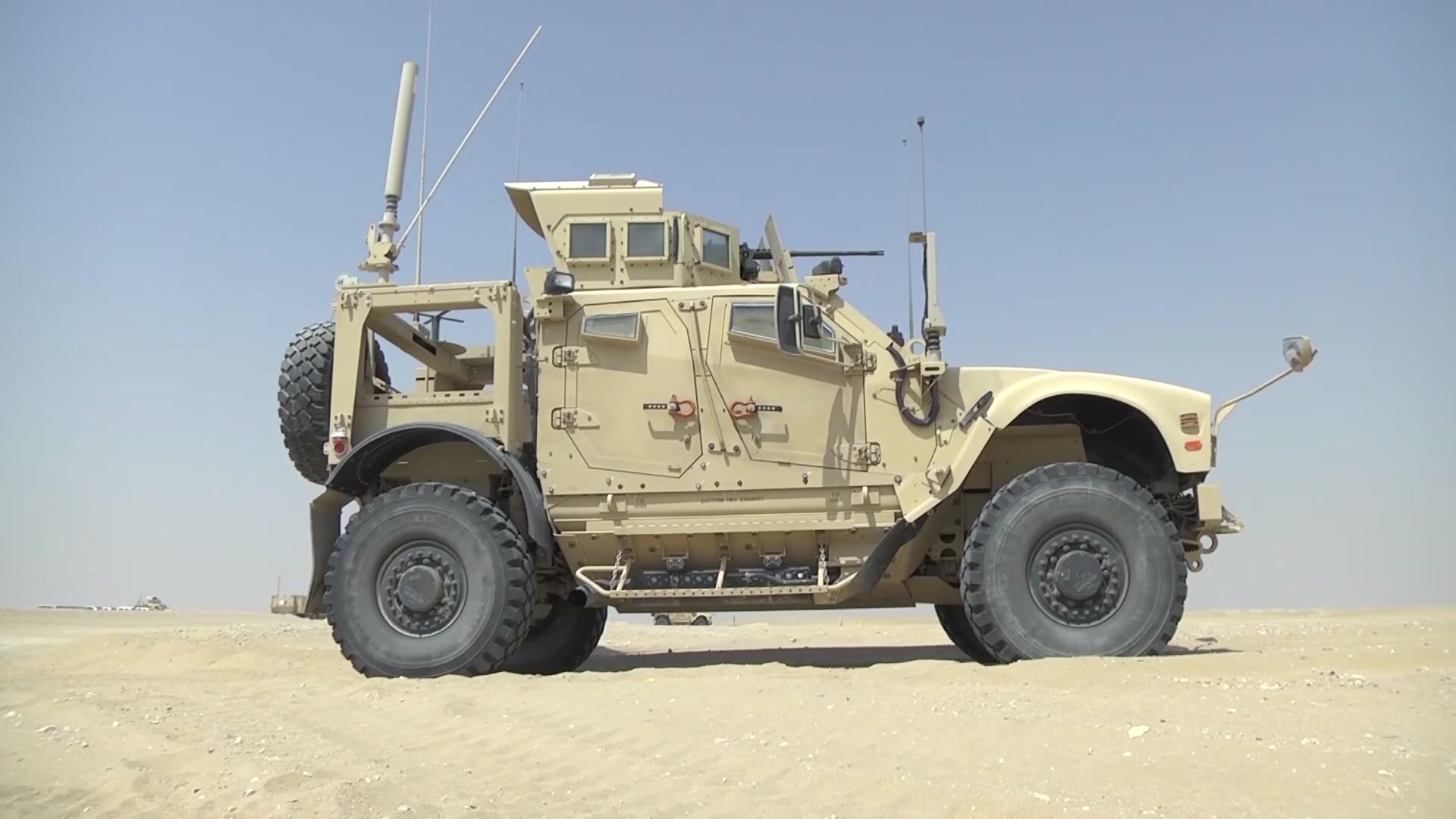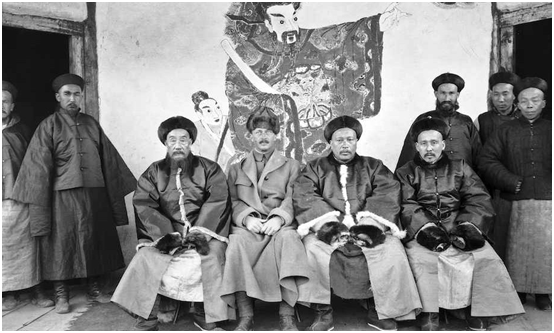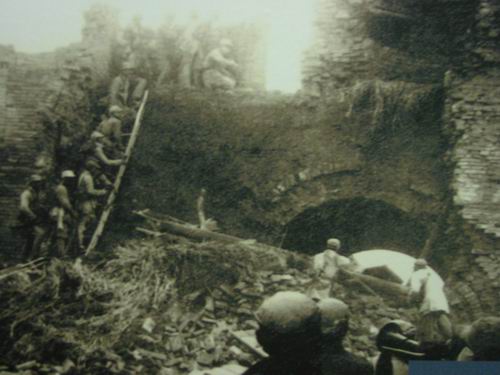|
4th Motorized Infantry Division (People's Republic Of China)
The 4th Division () was created in February 1949 under ''the Regulation of the Redesignations of All Organizations and Units of the Army'', issued by Central Military Commission on November 1, 1948,《中央军委关于统一全军组织及部队番号的规定》, http://blog.sina.com.cn/s/blog_7254c7350100xb56.html basing on the 4th Independent Brigade, 2nd Column of the PLA Northwest Field Army. Its history can be traced to the 4th Independent Brigade of Lvliang Military District, formed in November 1945. The division is part of 2nd Corps. Under the flag of 4th division it took part in the Chinese Civil War. In March 1953 it renamed as the 4th Infantry Division () of the National Defense Force and was transferred to Xinjiang Military Region's control. The division absorbed units from 5th and 6th Infantry Division as follows: *10th Infantry Regiment was formed from former 10th, 12th and Independent Regiment of 4th Division; *11th Infantry Regiment was formed from former 14th ... [...More Info...] [...Related Items...] OR: [Wikipedia] [Google] [Baidu] |
People's Republic Of China
China, officially the People's Republic of China (PRC), is a country in East Asia. With population of China, a population exceeding 1.4 billion, it is the list of countries by population (United Nations), second-most populous country after India, representing 17.4% of the world population. China spans the equivalent of five time zones and Borders of China, borders fourteen countries by land across an area of nearly , making it the list of countries and dependencies by area, third-largest country by land area. The country is divided into 33 Province-level divisions of China, province-level divisions: 22 provinces of China, provinces, 5 autonomous regions of China, autonomous regions, 4 direct-administered municipalities of China, municipalities, and 2 semi-autonomous special administrative regions. Beijing is the country's capital, while Shanghai is List of cities in China by population, its most populous city by urban area and largest financial center. Considered one of six ... [...More Info...] [...Related Items...] OR: [Wikipedia] [Google] [Baidu] |
People's Liberation Army Ground Force
The People's Liberation Army Ground Force (PLAGF), also referred to as the PLA Army, is the army, land-based service branch of the People's Liberation Army (PLA), and also its largest and oldest branch. The PLAGF can trace its lineage from 1927 as the Chinese Red Army; however, it was not officially established until 1948. History In February 1949, the existing large number of armies and divisions were regularized into up to seventy armies of three divisions each. While some, such as the 1st Army (People's Republic of China), 1st Army, survived for over fifty years, a number were quickly amalgamated and disestablished in the early 1950s. It appears that twenty per cent or even more of the seventy new armies were disestablished up to 1953; in 1952 alone, the 3rd Corps (People's Republic of China), 3rd, 4th Corps (People's Republic of China), 4th, 10th Corps (People's Republic of China), 10th, 17th Corps (People's Republic of China), 17th, 18th Corps (People's Republic of C ... [...More Info...] [...Related Items...] OR: [Wikipedia] [Google] [Baidu] |
Motorized Infantry
Motorized infantry is infantry that is transported by trucks or other motor vehicles. It is distinguished from mechanized infantry, which is carried in armoured personnel carriers or infantry fighting vehicles, and from light infantry, which can typically operate independently from supporting elements and vehicles for relatively long periods and may be airborne. Operations As defined by the United States Army, motorization is "the use of unarmored wheeled vehicles for the transportation of combat units."Infantry Division Transportation Battalion and Transportation, Tactical Carrier Units. (1962). United States: Headquarters, Department of the Army. p. 11 Motorizing infantry is the first stage towards the mechanization of an army. Civilian trucks are often readily adaptable to military uses of transporting soldiers, towing guns, and carrying equipment and supplies. Motorization greatly increases the strategic mobility of infantry units, which would otherwise re ... [...More Info...] [...Related Items...] OR: [Wikipedia] [Google] [Baidu] |
Division (military)
A division is a large military unit or Formation (military), formation, usually consisting of between 10,000 and 25,000 soldiers. In most armies, a division is composed of several regiments or brigades; in turn, several divisions typically make up a corps. Historically, the division has been the default combined arms unit capable of independent Military tactics, operations. Smaller combined arms units, such as the American regimental combat team (RCT) during World War II, were used when conditions favored them. In recent times, modern Western militaries have begun adopting the smaller brigade combat team (similar to the RCT) as the default combined arms unit, with the division to which they belong being less important. A similar word, ''Divizion, //'', is also used in Slavic languages (such as Russian, Serbo-Croatian, and Polish) for a battalion-size artillery or cavalry unit. In naval usage "division (naval), division" has a completely different range of meanings. Aboard ship ... [...More Info...] [...Related Items...] OR: [Wikipedia] [Google] [Baidu] |
Xinjiang Military District
The Xinjiang Military District (新疆军区) is a special military area of the PLA at the Theater Deputy-grade.(副战区级). It is one of three districts (Tibet and Beijing being the other two) that are directly under the Central Military Commission and its Joint Army Staff rather than under their Theater Command (in this case, the Western Theater Command.) The district includes all of Xinjiang, plus the Ngari district of Tibet. It has also direct military jurisdiction over the Xinjiang Production and Construction Corps (XPCC). History The Xinjiang Military District of the Chinese People's Liberation Army (PLA) was founded in December 1949 as a subordinate military area to the Northwest Military Region and was elevated to a major military region in May 1955, operating directly under the Central Military Commission's authority. In 1979, it was rebranded as the Urumqi Military Region; in June 1985, it amalgamated with the Lanzhou Military Region and concurrently estab ... [...More Info...] [...Related Items...] OR: [Wikipedia] [Google] [Baidu] |
Aksu, Xinjiang
Aksu (, ; zh, s=阿克苏, p=Ākèsū) is a city in and the seat of Aksu Prefecture, Xinjiang, lying at the northern edge of the Tarim Basin. The name Aksu literally means "white water" (in Turkic) and is used for both the oasis town and the Aksu River (Xinjiang), Aksu River. The economy of Aksu is mostly agricultural, with cotton, in particular long-staple cotton (''Gossypium hirsutum''), as the main product. Also produced are grain, fruits, oils and beets. The industry mostly consists of weaving, cement and chemical industries. The land currently under the administration of the Aksu City is divided in two parts, separated by the Aral, Xinjiang, Aral City. The northern part hosts the city center, while the southern part is occupied by the Taklamakan Desert. Aksu airport is considered a military airport in China (although also available for civil usage). Only aircraft registered in China can land in Aksu. This means if you are flying to Aksu from international origins you hav ... [...More Info...] [...Related Items...] OR: [Wikipedia] [Google] [Baidu] |
Chinese Civil War
The Chinese Civil War was fought between the Kuomintang-led Nationalist government, government of the Republic of China (1912–1949), Republic of China and the forces of the Chinese Communist Party (CCP). Armed conflict continued intermittently from 1 August 1927 until Communist victory resulted in their total control over mainland China on 7 December 1949. The war is generally divided into two phases with an interlude: from August 1927 to 1937, the First United Front alliance of the KMT and CCP collapsed during the Northern Expedition, and the Nationalists controlled most of China. From 1937 to 1945, hostilities were mostly put on hold as the Second United Front fought the Second Sino-Japanese War, Japanese invasion of China with eventual help from the Allies of World War II. However, armed clashes between the groups remained common. Exacerbating the divisions within China further was the formation of the Wang Jingwei regime, a Japan-sponsored puppet government led by Wang ... [...More Info...] [...Related Items...] OR: [Wikipedia] [Google] [Baidu] |
Sino-Indian War
The Sino–Indian War, also known as the China–India War or the Indo–China War, was an armed conflict between China and India that took place from October to November 1962. It was a military escalation of the Sino–Indian border dispute. Fighting occurred along India's border with China, in India's North-East Frontier Agency east of Bhutan, and in Aksai Chin west of Nepal. There had been a series of border skirmishes between the two countries after the 1959 Tibetan uprising, when India granted asylum to the Dalai Lama. Chinese military action grew increasingly aggressive after India rejected proposed Chinese diplomatic settlements throughout 1960–1962, with China resuming previously banned "forward patrols" in Ladakh after 30 April 1962. Amidst the Cuban Missile Crisis, seeing that the U.S. was pre-occupied with dealing with it, China abandoned all attempts towards a peaceful resolution on 20 October 1962,''Webster's Encyclopedic Unabridged Dictionary of the English ... [...More Info...] [...Related Items...] OR: [Wikipedia] [Google] [Baidu] |
Sino-Indian Border Dispute
The Sino–Indian border dispute is an ongoing territorial dispute over the sovereignty of two relatively large, and several smaller, separated pieces of territory between China and India. The territorial disputes between the two countries stem from the legacy of British colonial-era border agreements, particularly the McMahon Line in the eastern sector, which was drawn in 1914 during the Simla Convention between British India and Tibet but was never accepted by China. In the western sector, the dispute involves Aksai Chin, a region historically linked to the princely state of Jammu and Kashmir but effectively controlled by China after the 1962 war. The lack of mutually recognized boundary agreements has led to ongoing tensions and occasional military clashes. The first of the territories, Aksai Chin, is administered by China and claimed by India; it is mostly uninhabited high-altitude wasteland but with some significant pasture lands at the margins. It lies at the intersec ... [...More Info...] [...Related Items...] OR: [Wikipedia] [Google] [Baidu] |
2020–2021 China–India Skirmishes
Beginning on 5 May 2020, People's Liberation Army, Chinese and Indian Army, Indian troops engaged in aggressive melee, face-offs, and skirmishes at locations along the Sino-Indian border, including near the disputed Pangong Lake in Ladakh and the Tibet Autonomous Region, and near the border between Sikkim and the Tibet Autonomous Region. Additional clashes also took place at locations in eastern Ladakh along the Line of Actual Control (LAC). In late May, Chinese forces objected to Indian road construction in the Galwan River, Galwan river valley. According to Indian sources, melee fighting on 15–16 June 2020 resulted in the deaths of Chinese and Indian soldiers. Media reports stated that soldiers were taken captive on both sides and released in the coming few days while official sources on both sides went on to deny this. On 7 September, for the first time in 45 years, shots were fired along the LAC, with both sides blaming each other for the firing. Indian media also reported ... [...More Info...] [...Related Items...] OR: [Wikipedia] [Google] [Baidu] |
Northwest Field Army
The First Field Army of the Chinese Communist Party was a military formation in the last stages of the Chinese Civil War (1949–1950). The Northwest Field Army was originally under the command of Peng Dehuai with He Long and Xi Zhongxun as political commissars, which originally operated in Shanxi, Shaanxi, and Ningxia. It was 175,000 strong; most of its soldiers had been under the command of He Long during the war against Japan. He then became Peng's second-in-command. Peng's notable subordinates in the Northwest Field Army included Zhang Zongxun and Wang Zhen. Peng's forces were the most poorly armed of the newly re-organized army but were responsible for the area around the Chinese Communist Party (CCP) revolutionary base area, Yan'an. In March 1947, Kuomintang General Hu Zongnan, invaded the area with 260,000 soldiers. Hu's forces were among the best-trained and most well-supplied Nationalist units,Domes 45 but Xiong Xianghui, one of Zhou Enlai's spies, was able to provide ... [...More Info...] [...Related Items...] OR: [Wikipedia] [Google] [Baidu] |
2nd Corps (People's Liberation Army)
2nd Corps, Second Corps, or II Corps may refer to: France * 2nd Army Corps (France) * II Cavalry Corps (Grande Armée), a cavalry unit of the Imperial French Army during the Napoleonic Wars * II Corps (Grande Armée), a unit of the Imperial French army during the Napoleonic Wars Germany * II Cavalry Corps (German Empire), a unit of the Imperial German Army * II Corps (German Empire), a unit of the Imperial German Army * II Royal Bavarian Corps, a unit of the Bavarian Army and the Imperial German Army * II Royal Bavarian Reserve Corps, a unit of the Bavarian Army and the Imperial German Army * II SS Panzer Corps, a unit in World War II Russian Empire * 2nd Army Corps (Russian Empire) * 2nd Siberian Army Corps * 2nd Army Corps (Armed Forces of South Russia), a unit in the white movement Soviet Union * 2nd Airborne Corps (Soviet Union) * 2nd Rifle Corps * 2nd Guards Tank Corps United States * II Corps (United States), World War II * II Corps (Union Army), a unit in the Ameri ... [...More Info...] [...Related Items...] OR: [Wikipedia] [Google] [Baidu] |






